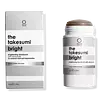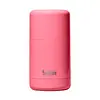Kaia Naturals The Takesumi Bright Brightening Deodorant with Niacinamide Versus Saltair Skincare Deodorant
What's inside
What's inside
 Key Ingredients
Key Ingredients

 Benefits
Benefits

 Concerns
Concerns

 Ingredients Side-by-side
Ingredients Side-by-side

Water
Skin ConditioningPropylene Glycol
HumectantEuphorbia Cerifera Wax
Maranta Arundinacea Root Powder
Skin ConditioningAloe Barbadensis Leaf Juice
Skin ConditioningSaccharomyces Ferment
Skin ConditioningSodium Stearate
CleansingStearyl Alcohol
EmollientBenzyl Alcohol
PerfumingSalicylic Acid
MaskingGlycerin
HumectantSorbic Acid
PreservativeCharcoal Powder
AbrasiveChamomilla Recutita Flower Extract
MaskingNiacinamide
SmoothingAlpha-Arbutin
AntioxidantCitrus Grandis Seed Extract
AstringentParfum
MaskingWater, Propylene Glycol, Euphorbia Cerifera Wax, Maranta Arundinacea Root Powder, Aloe Barbadensis Leaf Juice, Saccharomyces Ferment, Sodium Stearate, Stearyl Alcohol, Benzyl Alcohol, Salicylic Acid, Glycerin, Sorbic Acid, Charcoal Powder, Chamomilla Recutita Flower Extract, Niacinamide, Alpha-Arbutin, Citrus Grandis Seed Extract, Parfum
Caprylic/Capric Triglyceride
MaskingOzokerite
Emulsion StabilisingMaranta Arundinacea Root Powder
Skin ConditioningParfum
MaskingZinc Ricinoleate
Salicylic Acid
MaskingAscophyllum Nodosum Extract
Skin ConditioningLaminaria Digitata Extract
Skin ProtectingCalophyllum Inophyllum Seed Oil
AntimicrobialSaccharomyces Ferment
Skin ConditioningLauroyl Lysine
Skin ConditioningGlycerin
HumectantCocos Nucifera Oil
MaskingButyrospermum Parkii Butter
Skin ConditioningLimonene
PerfumingCoumarin
PerfumingHexyl Cinnamal
PerfumingCaprylic/Capric Triglyceride, Ozokerite, Maranta Arundinacea Root Powder, Parfum, Zinc Ricinoleate, Salicylic Acid, Ascophyllum Nodosum Extract, Laminaria Digitata Extract, Calophyllum Inophyllum Seed Oil, Saccharomyces Ferment, Lauroyl Lysine, Glycerin, Cocos Nucifera Oil, Butyrospermum Parkii Butter, Limonene, Coumarin, Hexyl Cinnamal
Ingredients Explained
These ingredients are found in both products.
Ingredients higher up in an ingredient list are typically present in a larger amount.
Glycerin is already naturally found in your skin. It helps moisturize and protect your skin.
A study from 2016 found glycerin to be more effective as a humectant than AHAs and hyaluronic acid.
As a humectant, it helps the skin stay hydrated by pulling moisture to your skin. The low molecular weight of glycerin allows it to pull moisture into the deeper layers of your skin.
Hydrated skin improves your skin barrier; Your skin barrier helps protect against irritants and bacteria.
Glycerin has also been found to have antimicrobial and antiviral properties. Due to these properties, glycerin is often used in wound and burn treatments.
In cosmetics, glycerin is usually derived from plants such as soybean or palm. However, it can also be sourced from animals, such as tallow or animal fat.
This ingredient is organic, colorless, odorless, and non-toxic.
Glycerin is the name for this ingredient in American English. British English uses Glycerol/Glycerine.
Learn more about GlycerinWe don't have a description for Maranta Arundinacea Root Powder yet.
Parfum is a catch-all term for an ingredient or more that is used to give a scent to products.
Also called "fragrance", this ingredient can be a blend of hundreds of chemicals or plant oils. This means every product with "fragrance" or "parfum" in the ingredients list is a different mixture.
For instance, Habanolide is a proprietary trade name for a specific aroma chemical. When used as a fragrance ingredient in cosmetics, most aroma chemicals fall under the broad labeling category of “FRAGRANCE” or “PARFUM” according to EU and US regulations.
The term 'parfum' or 'fragrance' is not regulated in many countries. In many cases, it is up to the brand to define this term.
For instance, many brands choose to label themselves as "fragrance-free" because they are not using synthetic fragrances. However, their products may still contain ingredients such as essential oils that are considered a fragrance by INCI standards.
One example is Calendula flower extract. Calendula is an essential oil that still imparts a scent or 'fragrance'.
Depending on the blend, the ingredients in the mixture can cause allergies and sensitivities on the skin. Some ingredients that are known EU allergens include linalool and citronellol.
Parfum can also be used to mask or cover an unpleasant scent.
The bottom line is: not all fragrances/parfum/ingredients are created equally. If you are worried about fragrances, we recommend taking a closer look at an ingredient. And of course, we always recommend speaking with a professional.
Learn more about ParfumSaccharomyces Ferment is created from fermenting and filtering saccharomyces, a group of fungus that includes yeasts. It is a humectant and helps hydrate the skin.
This ingredient contains amino acids, beta-glucan, and vitamins. Beta-glucan is a potent antioxidant and may help with the signs of aging.
This ingredient may not be fungal-acne safe.
Learn more about Saccharomyces FermentSalicylic Acid (also known as beta hydroxy acid or BHA) is a well-known ingredient for treating skin that struggles with acne and clogged pores. It exfoliates both the skin's surface and deep within the pores to help clear out buildup, control oil, and reduce inflammation.
Unlike AHAs (alpha hydroxy acids), salicylic acid is oil-soluble. This allows it to penetrate into pores which makes it especially effective for treating blackheads and preventing future breakouts.
Salicylic acid is also known for its soothing properties. It has a similar structure to aspirin and can calm inflamed or irritated skin, making it a good option for acne-prone skin that is also sensitive.
Concentrations of 0.5-2% are recognized by the U.S. FDA as an over-the-counter topical acne product.
It can cause irritation and/or dryness if one's skin already has a compromised moisture barrier, so it's best to focus on repairing that before introducing this ingredient into your routine.
While salicylic acid does not increase sun sensitivity, it’s still important to wear sunscreen daily to protect your skin.
If you are looking for the ingredient called BHA or Butylated Hydroxyanisole, click here.
Learn more about Salicylic Acid